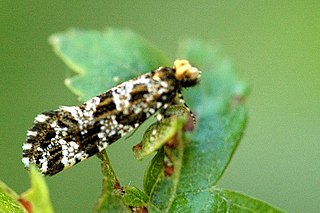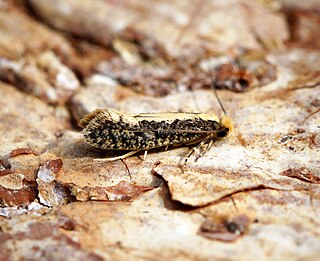
Tineidae is a family of moths in the order Lepidoptera described by Pierre André Latreille in 1810. Collectively, they are known as fungus moths or tineid moths. The family contains considerably more than 3,000 species in more than 300 genera. Most of the tineid moths are small or medium-sized, with wings held roofwise over the body when at rest. They are particularly common in the Palaearctic, but many occur elsewhere, and some are found very widely as introduced species.

Tineola bisselliella, known as the common clothes moth, webbing clothes moth, or simply clothing moth, is a species of fungus moth. It is the type species of its genus Tineola and was first described by the Swedish entomologist Arvid David Hummel in 1823. It and a number of closely-related species are together known as the clothes moths due to their role as pests in human households. The specific name is commonly misspelled biselliella – for example by G. A. W. Herrich-Schäffer, when he established Tineola in 1853.

Monopis obviella is a species of tineoid moth. It belongs to the fungus moth family (Tineidae), and therein to the nominate subfamily Tineinae. It is the type species of Blabophanes, today treated as a junior synonym of the genus Monopis. M. crocicapitella was only separated from the present species in 1859, and is still frequently confused with it even by rather recent sources.

Nemapogon granella is a species of tineoid moth. It belongs to the fungus moth family (Tineidae), and therein to the subfamily Nemapogoninae. It is the type species of its genus Nemapogon, and via that also of the subfamily Nemapogoninae. It is also the type species of the proposed genera Brosis and Diaphthirusa, which are consequently junior objective synonyms of Nemapogon.

Trichophaga tapetzella, the tapestry moth or carpet moth, is a moth of the family Tineidae, commonly referred to as fungus moths. It is found worldwide.

Triaxomera parasitella is a species of tineoid moth. It belongs to the fungus moth family (Tineidae), and therein to the subfamily Nemapogoninae. It is widespread and common in much of western Eurasia, but seems to be absent from some more outlying regions, such as Portugal and the eastern Baltic, Ireland and Iceland. It has also not been recorded from Slovenia but given that it is found in neighboring countries, it may well occur there unnoticed. Recently, the species was recorded from British Columbia. Generally, it is a moth of warm temperate regions, e.g. in Great Britain it is only a rare and scarce species from the English Midlands northwards.

Tinea semifulvella is a species of tineoid moth. It belongs to the fungus moth family (Tineidae), and therein to the nominate subfamily Tineinae. It is widespread and common in much of the western Palearctic, but seems to be absent from Portugal and the Balkans as well as the outlying islands. The nocturnal adults are on the wing around May to September, depending on the location, and are easily attracted to light sources.

Tinea pellionella, the case-bearing clothes moth, is a species of tineoid moth in the family Tineidae, the fungus moths. This species has a cosmopolitan distribution, occurring nearly worldwide.

The brown-dotted clothes moth is a species of tineoid moth. It belongs to the fungus moth family (Tineidae), and therein to the nominate subfamily Tineinae. It is the type species of its genus Niditinea.

Monopis is a genus of the fungus moth family, Tineidae. Therein, it belongs to the nominate subfamily, Tineinae.

Tinea trinotella is a species of tineoid moth. It belongs to the fungus moth family (Tineidae), and therein to the nominate subfamily Tineinae. It was once used as type species of a distinct genus Acedes, but this is synonymized today with Tinea, the type genus of Tineinae, Tineidae and the superfamily Tineoidea.

Tinea is a genus of the fungus moth family, Tineidae. Therein, it belongs to the subfamily Tineinae. As evident by its name, it is the type genus of its subfamily and family. Established as one of the first subgroups of "Phalaena", it used to contain many species of Tineidae that are nowadays placed in other genera, as well as a few moths nowadays placed elsewhere.

Monopis crocicapitella, the pale-backed clothes moth, or the bird-nest moth, is a moth of the family Tineidae described by James Brackenridge Clemens in 1859. It has a nearly cosmopolitan distribution. It was first described from the eastern United States.

Tinea pallescentella, the large pale clothes moth, is a moth of the family Tineidae. It is found in most of Europe. It is also present in western North America, where it has been recorded from California. There are also records from South America and Australia.

Tinea svenssoni is a moth of the family Tineidae. It is found in northern Europe, Russia, as well as North America where has been recorded from Québec.

Psychoides filicivora is a moth of the family Tineidae first described by Edward Meyrick in 1937. First found in Ireland in 1909, it is possible that the moth was introduced from imported ferns from Asia. The moth can be found from spring though autumn in a series of generations. The species overwinters as a larva.

Psychoides verhuella is a moth of the family Tineidae found in Europe. It was first described in 1853, by Charles Théophile Bruand d'Uzelle from a specimen from Besançon, France. It is the type species of the genus Psychoides, also raised by Charles Bruand in 1853. The larvae feed on ferns.

Tinea columbariella is a moth belonging to the family Tineidae. The species was first described by Wocke in 1877.
Tinea flavescentella is a species of moth belonging to the family Tineidae. It is native to Western Europe. The wingspan is 8–17 mm. Head with pale yellow hair tuts. Antennae just over half the front wing length. The forewings are greyish yellow with two or three grey-brown spots and a faint hyaline spot at the base. Hindwings grey. Certain identification requires examination of the genitalia.
Tinea dubiella is a species of moth belonging to the family Tineidae.



















